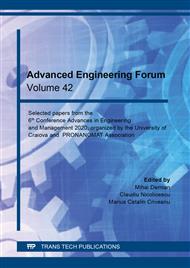p.17
p.24
p.30
p.36
p.42
p.50
p.57
p.63
p.71
Investigating the Effect of α-Fe2O3 Oxides on the BaFe2O4 Pyrosynthesis Temperature - The Digital Processing of TG and DTA Curves
Abstract:
In the research activities on the barium monoferrite pyrosynthesis, an important place is occupied by TG and DTA analysis. The effects of different hematite (α-Fe2O3) granulations on the BaFe2O4 pyrosynthesis temperature were followed. Four types of commercial hematite powders were used, the difference between them being the fineness of the powder granules and the purity. Only one type of commercial barium carbonate (BaCO3) powder was also used as a barium additive in the BaFe2O4 pyrosynthesis. Each of the 4 types of α-Fe2O3 with BaCO3 were subjected to the homogenization process in a planetary mill for a more intimate mixing of the powders in order to obtain error-free results regarding the pyrosynthesis reaction. To determine BaFe2O4 pyrosynthesis temperature, a derivatograph device was used. All the data obtained with this thermal device were digitally processed in order to extract the two TG and DTA curves. The protective atmosphere in the furnace was nitrogen. BaFe2O4 pyrosynthesis temperatures recorded different values for the four mixtures, depending on the particle size of the α-Fe2O3 powders, protective atmosphere from furnace and the mixing conditions. The effects of Fe2O3 oxides on the BaFe2O4 pyrosynthesis temperature is observed when are used very fine hematite powders in mixtures, obtaining a reduction of pyrosynthesis temperature up to 16% compared to the mixture where the size of the hematite is coarser.
Info:
Periodical:
Pages:
42-49
Citation:
Online since:
September 2021
Keywords:
Price:
Сopyright:
© 2021 Trans Tech Publications Ltd. All Rights Reserved
Share:
Citation:


